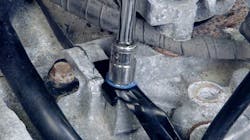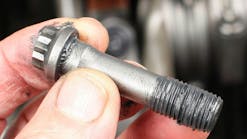Threadlockers are one of the all-time great mechanic’s helpers. They hold nuts and bolts in place to help ensure the quality of your repair, and they keep fasteners locked in place through heavy vibration, shock, and temperature cycling to help assure that your repair stays repaired.
Whether you’re a pro or a do-it-yourselfer, you’ve probably used threadlockers for as long as you’ve been doing repairs – they’re ‘standard issue’ in most every toolbox and garage. While you may know the basics of how to use threadlockers, there are a number of common mistakes people make when using threadlockers that can lead to incomplete holding power and issues down the line.
Here are eight common mistakes — from Permatex — that even some pros make when using a threadlocker:
Using too much threadlocker
Threadlockers only need to be applied to the first few threads on a fastener. Tightening the fastener will spread the threadlocker evenly. Using too much threadlocker can cause excess to spill out and migrate to unwanted areas.
Waiting for threadlocker to cure before installing the fastener
Threadlockers are anaerobic chemicals. They only cure in the absence of air and in the presence of active metals, such as iron, steel, and copper. Threadlockers won’t cure sitting out in the open air. The curing process only begins after you tighten up your fastener, which squeezes out the air. If you apply the threadlocker and wait for it to dry or get tacky, you’re just wasting time and risking contamination. With threadlockers, you can apply and install right away.
Using a threadlocker that’s too strong for your application
It may seem like you always want to use the strongest threadlocker for every application, but that’s not necessarily the case. The part may have to be disassembled in the future, either by you or another technician, and having a high strength bond in place can create problems in some applications.
Red threadlockers create the strongest bond, but they require the application of high heat, and the use of tools to disassemble. Not all assemblies can tolerate high heat. Many applications can be reliably locked in with blue (medium strength), purple (low strength), or green (penetrating) threadlockers. Read the product instructions and technical data sheet to know which threadlocker is appropriate for your job.
Ignoring application factors
There are environmental and materials issues that require special attention to ensure that threadlockers work as they’re designed:
- Cold temperatures can slow the threadlocker cure time.
- ‘Inactive’ metals like stainless steel, zinc, magnesium, or aluminum don’t promote anaerobic curing as well as ‘active metals’ like iron.
The fix for both of these issues is to apply an activator on the fastener such as Permatex Surface Prep Activator for Anaerobics. This will help ensure that the threadlocker cures and holds properly. Some mechanics prefer to apply a Surface Prep activator for every threadlocker application because activators will cut the cure time in half.
Not removing all of the old threadlocker before applying new threadlocker
If you don't remove all existing cured threadlocker from a fastener, the application of a new threadlocker will not work where the old material exists. Threadlockers are applied to just a few threads of the fastener. The action of installing the fastener spreads the threadlocker onto the remaining threads. If old, cured threadlocker is in place, it can stop the new threadlocker from being spread completely around the fastener, limiting the holding power of the newly applied threadlocker.
Improper use of tools to remove a thread locked fastener
Fasteners installed with medium strength (blue), low strength (purple), and penetrating (green) threadlockers can be disassembled with hand tools, but assemblies that have been put together using a high strength (red) threadlocker need the application of high heat (typically from a propane torch or induction heater) to break the bond. Trying to release a fastener without heat can result in bad things happening, such as broken bolt heads and busted knuckles.
Not waiting for the proper cure time
Threadlockers provide excellent holding power - but only after they’ve had time to cure. Typically, threadlockers achieve ‘fixture strength’ in 20 minutes and fully cure in 24 hours. Fixture strength means it’s okay to put your assembly back in service, but a full cure is when you’re getting the full holding power of the threadlocker.
Failing to clean the fastener and the threaded hole
Dirt, grease, and oil residue are all enemies of threadlockers. To get the full cure and full holding power of your threadlocker, the male and female threads need to be completely clean and dry. Don’t shortcut this step.
Whether you’re a full-time auto repair pro or dedicated do-it-yourselfer, threadlockers are a handy and valuable product you’ll want to use regularly. Keep clear of these common errors, and your assemblies (and your customers) will thank you.







